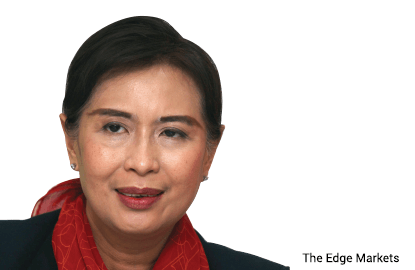
This article first appeared in Personal Wealth, The Edge Malaysia Weekly, on March 14 - 20, 2016.

AmFunds Management Bhd (AmInvest) continued its exceptional performance by taking home three individual awards at The Edge-Thomson Reuters Lipper Fund Awards 2016.
For the third consecutive year, the AmDynamic Bond fund won the award for Best Bond Malaysian Ringgit in the 10-year category. The AmAsean Equity Fund won the award for Best Equity Asean in the three-year category, while the AmCumulative Growth fund won the award for Best Equity Asia Pacific Ex-Japan in the 10-year category.
In terms of the fund house’s fixed income investments, chief investment officer for fixed income Goh Wee Peng says it was able to take advantage of market conditions with its long-term structural strategy and investment philosophy, which is a three-pronged process — directional view based on macro top-down approach, relative valuation and volatility management.
“The macro top-down approach involves economic analysis and the process is aided by an experienced in-house economist. Selection of credits will be done in the relative valuation process based on our in-house credit valuation model. Volatility management was mitigated through high conviction asset allocation and duration management,” she explains.
Goh adds that the outstanding performance was achieved with the “high conviction” strategy it employed, coupled with active management in accordance with macro view and market timing. In addition, the fund manager continued to add value by actively managing tactical duration and yield curve positioning and exploiting credit spread arbitrage.
The investment strategy for fixed income was also formulated and styled with other considerations, which are based on the global and domestic interest rate outlook, interest rate disparity among peers, relative valuation on credit spread analysis, fund flows analysis, demand and supply analysis on issuance pipeline, and currency analysis.
 Goh says that during the first quarter of last year, there was a large number of private debt securities (PDS) and Goldcorp issuances. “This was due to issuers rushing into funds in anticipation of a possible Federal Reserve rate hike. Seeing this as an opportunity for the fixed income funds, we cherry-picked and extended our duration from underweight to neutral and slightly overweight. Other than that, we went down the credit ladder and bought into good quality lower-rated credit to achieve a higher portfolio running yield.”
Goh says that during the first quarter of last year, there was a large number of private debt securities (PDS) and Goldcorp issuances. “This was due to issuers rushing into funds in anticipation of a possible Federal Reserve rate hike. Seeing this as an opportunity for the fixed income funds, we cherry-picked and extended our duration from underweight to neutral and slightly overweight. Other than that, we went down the credit ladder and bought into good quality lower-rated credit to achieve a higher portfolio running yield.”
In the third quarter, the market rallied due to the front loaded issuances during the year, she adds. The strong demand swept the market into bullish mode, causing the yield curve to flatten. The fund house’s fixed income team started to take profit in the middle of the third quarter as its reading showed expensive valuations.
In 2015, the most challenging situation the fund house’s fixed income team faced was when it miscalculated the Fed’s interest rate hike. Market volatility and ringgit depreciation were also some of the threats.
“The domestic market seemed to have priced in too much negativity, and the rate hike was too aggressive for the Fed. Unfortunately, the pace of global recovery has remained subdued,” says Goh.
AmInvest chief investment officer for equities Andrew Wong attributes the success of the equity funds to the fund house’s structure. “We have specialised teams consisting of talented staff working together for the past 10 years. Our investment philosophy includes having a dedicated top-down country allocation and bottom-up stock selection approach.”
The philosophy, he says, remains consistent with an approach that is driven by rigorous research in asset allocation and stock selection. AmInvest’s asset allocation strategy for equities was overweighting the technology sector while underweighting banks. In terms of countries, the fund house was overweight on Indonesia while underweight on Hong Kong and China.
Wong says that throughout the year, the equities team exercised significant active tactical rebalancing based on key factors, such as valuation and turn of events. Meanwhile, its strategic country asset allocation remained the same, based on the longer-term outlook.
Wong feels that most of the markets in Asia lack excitement. “We will continue to underweight China, Hong Kong and technology for the near term until better clarity surfaces while maintaining our overweight stance on Indonesia and the Philippines. As for now, dividend yielders are preferred,” he says, adding that unit trust investors are expected to gain mid-single-digit returns in an environment of low interest rates.
If growth prospects worsen, Goh expects a further cut in the simple rate of return or even interest rate adjustment in the second quarter. “Therefore, we are extending our duration to overweight. In terms of credit exposure selection, we continue to cautiously participate in good lower-rated PDS for additional yield pick-up and to ride the spread widening trend, especially the lower-rated segment of the credit curve,” she says.
According to AmInvest CEO Datin Maznah Mahbob, the fund house’s assets under management (AUM) remained stable despite the year’s adverse market conditions. She says the inflows from three new fund launches, select global funds and bond exchange traded funds were offset by the outflows in fixed-income funds.
“So far this year, the markets have been challenging, affecting investor sentiment and posing a drag on potential AUM growth. Most of our funds delivered healthy returns in the midst of market negativity last year and we hope this will give investors the confidence to continue investing in our funds, enabling us to generate a decent AUM growth of at least 5%.”
Going forward, the fund house hopes to launch more closed-end bond funds and global funds this year, she adds.